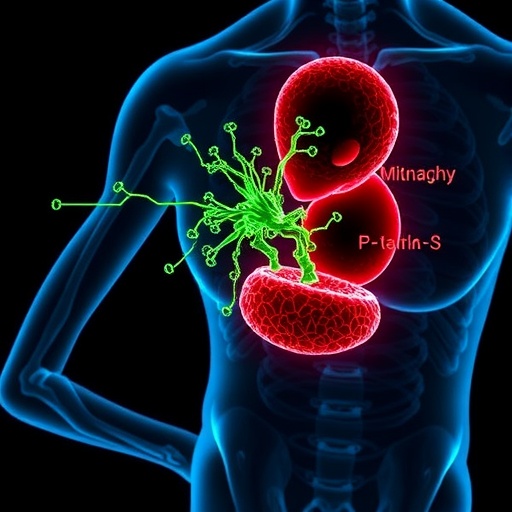
In a groundbreaking study published in BMC Endocrine Disorders, researchers have unearthed compelling evidence regarding the relationship between the apparent diffusion coefficient (ADC) and the effectiveness of glucocorticoid therapy in patients suffering from active moderate-to-severe thyroid eye disease (TED). This retrospective cohort study, meticulously conducted by Zhang et al., sheds light on the potential of ADC to act as a biomarker that predicts therapeutic outcomes for patients undergoing steroid treatment.
Thyroid eye disease, a complex autoimmune condition affecting the orbit and surrounding tissues, often manifests as inflammation and swelling. The condition, associated with hyperthyroidism, leads to debilitating symptoms that can severely impact the quality of life. Current treatments typically include corticosteroids to manage the inflammatory processes; however, the response to this therapy is variable among patients, highlighting the urgent need for predictive measures.
In this study, researchers sought to understand whether ADC could serve as a quantifiable imaging biomarker indicative of the effectiveness of glucocorticoid therapy. The apparent diffusion coefficient, derived from diffusion-weighted magnetic resonance imaging (DW-MRI), reflects the motion of water molecules within tissues and is influenced by cellular density and tissue characteristics. In the context of TED, atypical water diffusion patterns could signal changes in disease activity and response to treatment.
The retrospective nature of the study allowed researchers to analyze imaging data of patients diagnosed with moderate-to-severe TED who received glucocorticoid therapy. By assessing pre-treatment and post-treatment ADC values, they aimed to establish a correlation between changes in ADC and clinical outcomes, such as symptom relief and objective measures of disease severity.
Results from this retrospective cohort study were striking. A significant reduction in ADC values post-treatment was observed in patients who responded favorably to glucocorticoid therapy. In contrast, patients who exhibited minimal or no clinical improvement displayed static or even increased ADC values. This pattern strongly suggests that ADC, as a non-invasive imaging biomarker, could aid clinicians in determining which patients are likely to benefit from corticosteroid treatment.
Additionally, the research highlighted the importance of individualized treatment plans in managing thyroid eye disease. By utilizing ADC measurements, healthcare providers could tailor therapeutic strategies more effectively, potentially sparing patients from prolonged courses of ineffective therapies. This shift towards precision medicine not only optimizes patient care but also addresses the broader public health implications of managing chronic autoimmune conditions.
A critical aspect of this research was the emphasis on the technique employed to measure ADC. The study utilized rigorous imaging protocols alongside standardized methods for ADC calculation, ensuring the reliability of results. DW-MRI, while already recognized for its applications in oncology, has now found a promising role within endocrinology, showcasing the versatility of advanced imaging technologies in clinical practice.
The implications of this study extend beyond the immediate context of TED. Should further validation studies confirm these findings, ADC could potentially become a standard metric used in various inflammatory conditions characterized by tissue edema and cellular infiltration. As researchers delve deeper into exploring other applications of ADC, it could pave the way for new diagnostic pathways and therapeutic strategies in other autoimmune diseases.
This innovative research not only underscores the connection between imaging technologies and clinical outcomes but also invites a reevaluation of how we assess treatment efficacy in the context of chronic diseases. The approach taken in this study exemplifies the evolving landscape of medical research, where interdisciplinary collaboration between radiologists, endocrinologists, and researchers is vital.
Furthermore, this research opens the door to future studies aimed at understanding the underlying mechanisms linking ADC values with disease pathophysiology. Insights gained from elucidating these connections could inform the development of new therapeutic targets, thereby enhancing our overall understanding of thyroid eye disease and its complex biological interactions.
It is essential to note that while the findings from Zhang et al. are promising, they should be interpreted with caution. As a retrospective study, inherent limitations such as selection bias and incomplete data could affect the generalizability of results. Therefore, prospective studies involving larger patient populations are warranted to further establish the role of ADC as a reliable predictor of treatment response in thyroid eye disease.
As the medical community continues to embrace personalized medicine, the integration of advanced imaging techniques such as DW-MRI into routine clinical practice may transform how we approach the diagnosis and treatment of thyroid eye disease and similar conditions. The future is bright for patient care, as tools allowing for more precise, individualized interventions become available.
In conclusion, this innovative research highlights the potential for ADC to serve as a predictive marker of glucocorticoid efficacy in patients with thyroid eye disease. As our understanding of the disease progresses, so too will our approaches to treatment, guided by cutting-edge science and technology. With continued investigation, ADC may soon become a cornerstone of effective management strategies in thyroid eye disease, improving patient outcomes and fostering new avenues for research exploration.
Subject of Research: The predictive role of apparent diffusion coefficient in glucocorticoid therapy efficacy for thyroid eye disease.
Article Title: Apparent diffusion coefficient: a predictor of the efficacy of glucocorticoid therapy in active moderate-severe thyroid eye disease: a retrospective cohort study.
Article References:
Zhang, M., Zhang, X., Huang, Q. et al. Apparent diffusion coefficient: a predictor of the efficacy of glucocorticoid therapy in active moderate-severe thyroid eye disease: a retrospective cohort study. BMC Endocr Disord 25, 177 (2025). https://doi.org/10.1186/s12902-025-01981-6
Image Credits: AI Generated
DOI:
Keywords: Thyroid eye disease, glucocorticoids, apparent diffusion coefficient, biomarkers, precision medicine, retrospective cohort study.
Tags: ADC as a therapeutic outcome indicatorautoimmune conditions and glucocorticoidsdiffusion coefficient in thyroid eye diseasediffusion-weighted magnetic resonance imagingglucocorticoid therapy effectivenessimaging biomarkers in endocrinologyinflammation and swelling in thyroid eye diseasepredictive biomarkers for steroid treatmentquality of life in thyroid eye disease patientsresearch on thyroid eye disease treatmentsretrospective cohort study on TEDthyroid eye disease management




